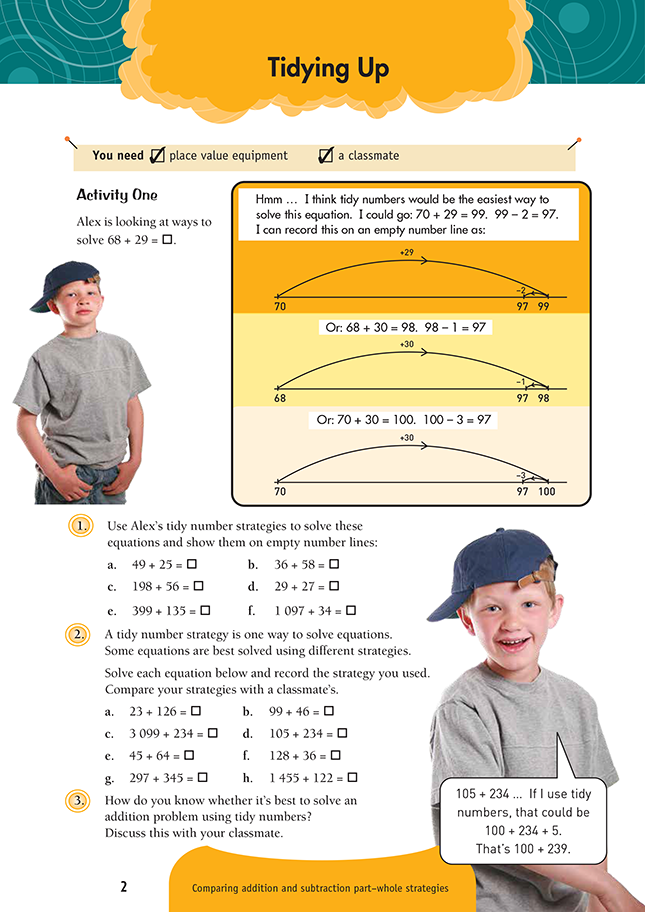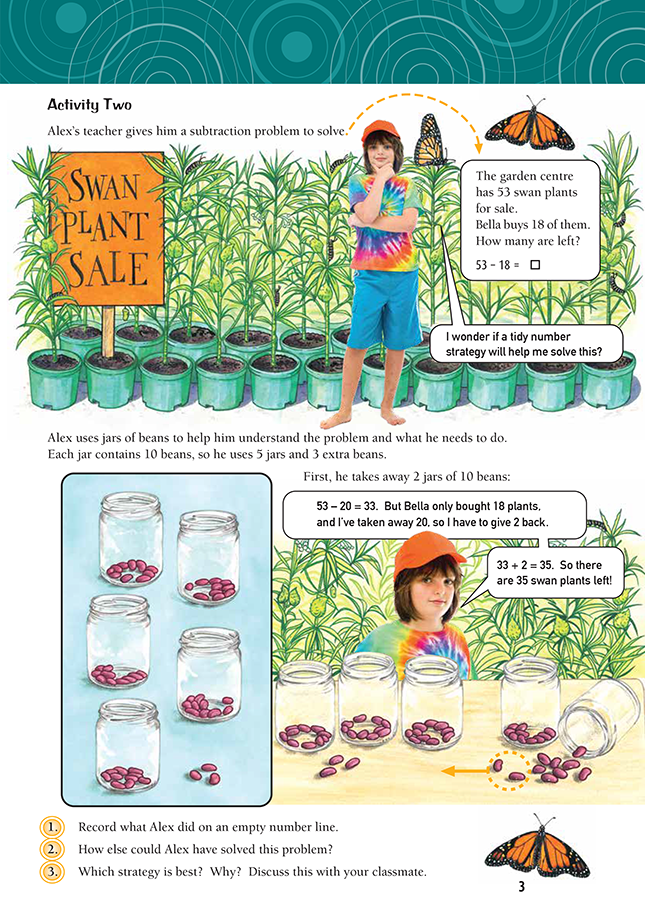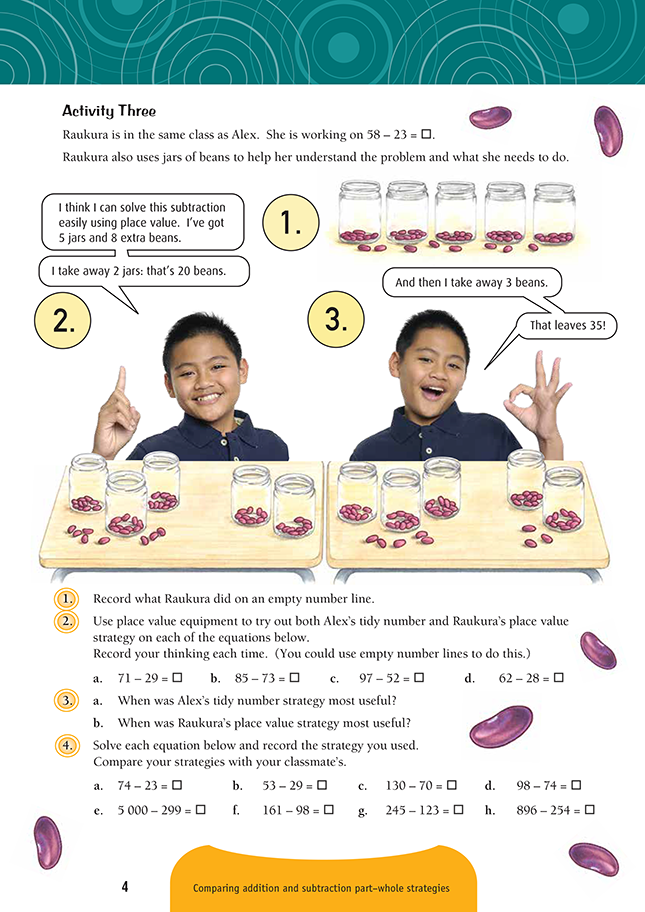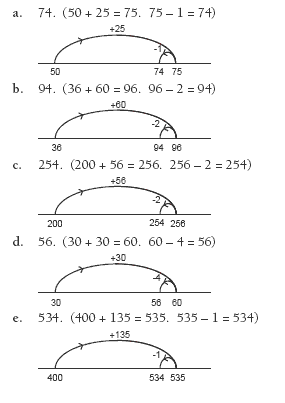This is a level 3 number activity from the Figure It Out series. It relates to Stage 6 of the Number Framework.
A PDF of the student activity is included.
Click on the image to enlarge it. Click again to close. Download PDF (515 KB)
use tidy numbers to solve addition and subtraction problems
Number Framework Links
Use these activities to:
• promote transition from early additive strategies (stage 5) to advanced additive strategies (stage 6) by supporting the students’ use of a range of addition and subtraction strategies
• help the students to extend and consolidate advanced additive part–whole strategies (stage 6) in addition and subtraction.
Numeracy Professional Development Project learning experiences that will help to develop students’ understanding of these strategies are listed at the end of the notes for this activity. (Many of the notes in this book contain similar references.)
Place value equipment
FIO, Level 3, Number Sense and Algebraic Thinking, Book One, Tidying up, pages 2-4
A classmate
Activities One, Two, and Three
In these activities, students use and compare strategies for addition and subtraction, focusing on tidy numbers and compensation and on place value partitioning strategies.
These activities would be useful as a follow-up to exploring tidy number and place value strategies.
Here is a useful summary of these strategies:
• In the tidy number and compensation strategy, students add or subtract a close tidy number, usually a multiple of 10 or 100, then adjust the answer to compensate.For example, 53 – 18 = (53 – 20) + 2.
• In the place value partitioning strategy, students break the numbers up into their place value components and then add or subtract them one part at a time. For example, to solve 58 – 23, the 23 could be partitioned into (20 + 3) and taken off one part at a time. 58 – 20 = 38, then 38 – 3 = 35. Another way to use this strategy is to break up both the numbers so 58 – 23 becomes (50 + 8) – (20 + 3). This can be solved by grouping place value numbers: 50 – 20 = 30 and 8 – 3 = 5. 30 + 5 is 35.
Students will need to work in pairs or small groups to complete parts of these activities. Before they start, ensure that they understand what Alex has done in Activity One by asking them to solve 49 + 25 using his strategy. For example: 49 + 25 = (50 + 25) – 1
= 75 – 1
= 74
Ask:
Why is it a good idea to know how to solve a problem using lots of different strategies?
(Different numbers suit different strategies, and the best strategy is the one that you find quickest and easiest in that situation. By using different strategies, we learn more about how numbers behave when we use the operations.)
When a strategy is “efficient”, what does that mean? (It gets you the answer quickly and easily, with as few steps as possible. This usually means less mental effort is required.)
You may need to define these terms:
• Tidy number: multiples of 10, 100, and 1 000.
• Equation: a number sentence that contains an equals sign.
These activities are also suitable for use with a guided teaching group. The initial parts ofActivity One and Activity Three lend themselves to the Numeracy Project strategy teaching model that uses materials, images, and number properties. That is, the students move from materials to symbols to words. (See Book 3: Getting Started.)
Students who need to use materials could solve Alex’s problem (or Raukura’s in Activity Three) using place value equipment such as canisters and beans, bundled sticks, or tens money ($100, $10, $1). Record what the students do on an empty number line when they share their solution paths with the group.
When the students are able to solve the problems successfully, promote imaging by setting up the beans and canisters behind a screen for each problem and asking the students to describe what is there and what they would do to manipulate the materials to solve the problem. Alternatively, you could ask them to describe the hops they would make on an empty number line. If necessary, let the students remove the screen and move the materials or draw the hops on a number line as they share their solution paths with the group.
Using number properties is the next step. Students who are using imaging successfully to solve problems may be able to move on to using just the numbers. They need to understand the number properties involved before going on to compare strategies or to classify the types of problem suited to a particular strategy.
Some students are reluctant to use a variety of strategies and prefer to use one trusted method, even if it is less efficient. Some ways to give your students more practice in trying different strategies are:
• Suggest: Let’s all use Alex’s method to solve this next problem.
• Have group discussions about why being able to use a variety of strategies is useful.
• When groups are sharing their different strategies, record them all on one empty number line, using different colours for each strategy. Ask the group which strategies were most efficient (that is, that were streamlined and fast, needing fewer hops on the number line).
• Sometimes, deliberately choose numbers for problems that would be cumbersome for the student’s preferred method but very quick using a different strategy.
• Emphasise the importance of efficiency by asking questions such as: Now that you’ve solved this problem, what would you do differently next time with a similar problem? or Is there a faster way of solving that problem?
Many of the problems in these activities could also be solved efficiently by adding on. For example, for 64 – 38: “I started at 38 and hopped up 2 to 40, then 24 more to 64. 2 + 24 = 26.” The intention of this activity is to compare the efficiency of different strategies, so welcome any alternative efficient strategies that are offered for discussion
Key questions to promote algebraic thinking include:
What is it about the numbers in that problem that made you choose that strategy?
Can you make up another problem that would be good for the tidy number strategy or the place value strategy?
For Activity One, question 3, and Activity Three, question 3, ask the students when tidy number or place value strategies would be most useful. You can use this to observe whether the students are able to articulate any generalisations they may have made.
Tidy number strategies are always useful when one number in an addition problem is close to a tidy number (that is, it ends in 1, 2, 3 or in 7, 8, 9) or in subtraction problems when the number you are taking away is close to a tidy number (such as 65 – 29).
Place value strategies are most useful in addition problems where there is no renaming (for example, 42 + 53) or in subtraction problems where the digits in the number you are taking away are smaller than the ones in the same place in the larger number so that you don’t have to do any renaming (for example, 76 – 32). Place value strategies are always useful, but they are not always convenient. For example, 93 – 46 involves renaming, but it works if “back through 10” is known:
Some suggestions for reflective discussion include:
Is there a strategy that you’ve seen or used today that you’d like to use more often?
What kinds of numbers or problems will you be looking out for to try with this strategy? Give me an example.
Answers to Activities
Activity One
1. Tidy number strategies will vary. One possible strategy and its matching number line is shown for each answer.
f. 1 131. (1 100 + 40 = 1 140.
1 140 – 9 = 1 131)
2. Strategies may vary. A possible strategy for each answer is given below.
a. 149. Using place value: 20 + 120 = 140, 3 + 6 = 9. 140 + 9 = 149
b. 145. Using tidy numbers: 100 + 46 = 146. 146 – 1 = 145
c. 3 333. Using tidy numbers: 3 100 + 234 = 3 334. 3 334 – 1 = 3 333
d. 339. Using place value: 100 + 200 = 300, 5 + 34 = 39. 300 + 39 = 339
e. 109. Using place value: 40 + 60 = 100, 5 + 4 = 9. 100 + 9 = 109
f. 164. Using tidy numbers: 130 + 36 = 166. 166 – 2 = 164
g. 642. Using tidy numbers: 300 + 345 = 645. 645 – 3 = 642
h. 1 577. Using place value: 400 + 100 = 500, 50 + 20 = 70, 5 + 2 = 7.
1 000 + 500 + 70 + 7 = 1 577
3. The tidy number strategy is always useful when one number, such as 21 or 198, is close to a tidy number (20 or 200). Usually, the number being “tidied” will end in 1, 2, or 3 or in 7, 8, or 9.
Activity Two
2. Possible strategies include:
• Reverse the problem (18 + = 53) and add on. 18 + 2 = 20. 20 + 33 = 53.
2 + 33 = 35
• Make equal adjustments. Add 2 to each number: 55 – 20 = 35
3. Opinions will vary.
• Alex’s strategy makes it easier to subtract mentally.
• Reversing and adding on is also a good method if you jump off tidy numbers.
It’s easy to add 2 to 3 at the end.
• Place value strategy may not be as useful in this problem because you have to do
43 – 8, which involves breaking up a 10.
• Taking away 20 is easier than taking away 18.
Activity Three
2. Solutions and possible thinking are:
a. 42
Tidy number: 71 – 30 = 41. 41 + 1 = 42
Place value: 71 – 20 = 51. 51 – 9 = 42
b. 12
Tidy number: 85 – 70 = 15. 15 – 3 = 12
Place value: 80 – 70 = 10. 5 – 3 = 2.
10 + 2 = 12
c. 45
Tidy number: 97 – 50 = 47. 47 – 2 = 45
Place value: 90 – 50 = 40. 7 – 2 = 5.
40 + 5 = 45
d. 34
Tidy number: 62 – 30 = 32. 32 + 2 = 34
Place value: 62 – 20 = 42. 42 – 8 = 34
3. a. A tidy number strategy is most useful when the number that you are taking away is close to a tidy number.
b. Place value strategy is easier when the digits in each corresponding place are smaller in the number you are taking away so that you don’t have to break any tens or rename. For example, for 85 – 73, it’s easy to subtract 80 – 70 and then 5 – 3.
4. Strategies will vary. Efficient strategies include:
a. 51. Place value: 70 – 20 = 50, 4 – 3 = 1. 50 + 1 = 51 or 74 – 20 = 54. 54 – 3 = 51
b. 24. Tidy numbers: 53 – 30 = 23. 23 + 1 = 24
Adding on: 29 + = 53. 29 + 1 = 30.
30 + 23 = 53. 1 + 23 = 24
c. 60. Place value:
13 tens – 7 tens = 6 tens or 60
Adding on: 70 + = 130. 70 + 30 = 100.
100 + 30 = 130. 30 + 30 = 60
d. 24. Place value: 90 – 70 = 20, 8 – 4 = 4.
20 + 4 = 24
Adding on: 74 + = 98. 74 + 6 = 80.
80 + 18 = 98. 6 + 18 = 24
e. 4 701. Tidy numbers: 5 000 – 300 = 4 700.
4 700 + 1 = 4 701
Adding on: 299 + = 5 000.
299 + 1 = 300. 300 + 700 = 1 000.
1 000 + 4 000 = 5 000.
1 + 700 + 4 000 = 4 701
f. 63. Tidy numbers: 161 – 100 = 61.
61 + 2 = 63
Adding on: 98 + = 161. 98 + 2 = 100.
100 + 61 = 161. 2 + 61 = 63
g. 122. Place value: 200 – 100 = 100,
40 – 20 = 20, 5 – 3 = 2.
100 + 20 + 2 = 122
h. 642. Place value: 800 – 200 = 600,
90 – 50 = 40, 6 – 4 = 2.
600 + 40 + 2 = 642





